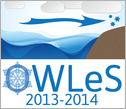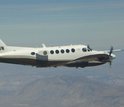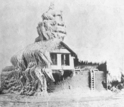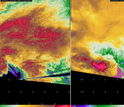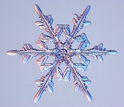News Release 13-191
Scientists brave Old Man Winter to dig out secrets of lake-effect snows
Researchers collect data along Lake Ontario in December and January blizzards

During the OWLeS project, scientists will dash through the snow in the Doppler-on-Wheels.
November 18, 2013
This material is available primarily for archival purposes. Telephone numbers or other contact information may be out of date; please see current contact information at media contacts.
Note: OWLeS Project scientists hold a "Media Day" on Dec. 4, 2013, at New York's Penn Yan Airfield.
'Tis the season...for snow.
Thundersnow.
Rare anywhere, thundersnow is sometimes heard during the lake-effect snowstorms of the Great Lakes. The interaction of clouds and ice pellets inside these storms generates a charge, with lightning and thunder the result.
How to catch thundersnow in action? This winter, stalwart veterans of tornadoes, hurricanes and other severe storms will be watching.
One is known as the Doppler-on-Wheels (DOW), a National Science Foundation (NSF) national facility used by NSF-supported and other researchers. Joining it is a University of Wyoming instrumented aircraft, the King Air, also an NSF-funded national facility.
In rain, sleet or snow, like the postman, they always deliver...storm data.
Using the DOW, the King Air and other equipment, scientists from across the country will converge on the shores of Lake Ontario from Dec. 5-21, 2013, and Jan. 4-29, 2014.
They will work to better understand the atmospheric conditions and mechanisms that lead to the deep snows that accumulate across the region each winter.
The project is called OWLeS (Ontario Winter Lake-effect Systems). OWLeS is funded by NSF and is a collaborative effort of nine universities.
Participating institutions are the University of Wyoming, University of Illinois, University of Utah, State University of New York (SUNY) Oswego, Hobart and William Smith Colleges, Millersville University, Penn State University, University of Alabama in Huntsville, SUNY Albany and the Center for Severe Weather Research (CSWR) in Boulder, Colo.
Although lake-effect snowstorms happen near all the Great Lakes, the New York area along Lake Ontario has some of the deepest snowfalls. Average annual snow reaches more than 100 inches. Nearby locations, such as the Tug Hill Plateau, may be blanketed with more than 250 inches each year.
But lake-effect snows aren't limited to the shores of Lake Ontario.
New York's Finger Lakes region also bears the brunt of lake-enhanced snowstorms. Complex interactions between the local environment and the far-reaching influence of Lake Ontario can significantly affect the location of lake-effect snowbands, says scientist Scott Steiger of SUNY Oswego.
"Even winter-hardened Great Lakes residents and infrastructure can be severely affected by heavy lake-effect snows," says Brad Smull, program director in NSF's Division of Atmospheric and Geospace Sciences, which funded the research.
"OWLeS' unique suite of modern mobile observing equipment and computer-based storm models will help us understand the processes that control the timing and location of these zones of heavy snow."
OWLeS scientists will use a network of specialized weather instrumentation--including three DOWs, the King Air, several weather balloon sounding systems, and a vertically-pointing radar wind profiler---to study the inner workings of lake-effect snowstorms.
The DOW and the King Air will intercept the lake-effect snowbands that cause the heavy snowfalls of the Lake Ontario region.
The King Air will fly over Lake Ontario, collecting data on snow and ice pellets, temperatures and other properties inside lake-effect snowbands.
The DOW looks more like the dish of a radio telescope than a sophisticated weather instrument. It's mounted on the back of a flat-bed truck. DOW-on-board, the truck becomes an odd configuration of generator, equipment and operator cabin.
Ungainly as it may appear, it's ideally suited to providing detailed information on the inner workings of snowstorms, says Josh Wurman, CSWR director.
The DOW uses Doppler radar to produce velocity data about objects--such as severe storms--at a distance.
"The King Air also carries Doppler radar that will transect the snowbands and a lidar that will show how the bands first form near the upwind side of the lake," says Bart Geerts of the University of Wyoming, co-lead scientist on the project with David Kristovich of the University of Illinois at Urbana-Champaign.
Lakes upwind of Lake Ontario can have a big influence on how heavily, and where, lake-effect snows fall.
"Air that has been moistened and mixed by moving over Lake Huron, Lake Michigan and even Lake Superior can play a major role in the large amount of snow that falls in the Lake Ontario snowbelt," says Kristovich.
Some of the questions scientists will investigate during OWLeS include:
What environmental factors have the greatest influence on the amount of snowfall and location of snowbands over and near Lake Ontario?
How do other Great Lakes affect the amount of snow that falls near Lake Ontario?
How does the interplay between winds and clouds produce long-lived snowbands far downstream of open water?
How does the local terrain influence the strength and longevity of these systems?
As snows begin to fall, the researchers will head out to collect data. The results will lead to increased predictability of, and preparedness for, Old Man Winter.
-NSF-
-
The OWLeS lake-effect snowstorm project takes place in December 2013 and January 2014.
Credit and Larger Version -
The University of Wyoming King Air, funded by NSF, will also participate in OWLeS.
Credit and Larger Version -
"Historic" snowstorms are the norm in Oswego, N.Y.; DOW and King Air will be there to catch them.
Credit and Larger Version -
A rotating cell in a snowband making landfall from Lake Ontario over Fair Haven, N.Y.
Credit and Larger Version -
A stellar dendrite snow crystal. Dendritic means tree-like; these snowflakes have branches.
Credit and Larger Version
Media Contacts
Cheryl Dybas, NSF, (703) 292-7734, email: cdybas@nsf.gov
Related Websites
OWLeS Project: http://owles.org
Inside a Snowstorm: Scientists Obtain Close-Up Look at Old Man Winter: http://www.nsf.gov/news/news_summ.jsp?cntn_id=118365
Dashing Through the Snow, in a One-truck Radar Dish: http://www.nsf.gov/discoveries/disc_summ.jsp?cntn_id=122491
Eye-to-Eye With a Blizzard ...Tornado ... Hurricane: http://www.nsf.gov/discoveries/disc_summ.jsp?org=NSF&cntn_id=118048
Collaborative Research: Ontario Winter Lake-effect Systems-Surface and Atmospheric Influences on Lake-effect Convection (OWLeS): http://www.nsf.gov/awardsearch/showAward?AWD_ID=1259004&HistoricalAwards=false
The U.S. National Science Foundation propels the nation forward by advancing fundamental research in all fields of science and engineering. NSF supports research and people by providing facilities, instruments and funding to support their ingenuity and sustain the U.S. as a global leader in research and innovation. With a fiscal year 2023 budget of $9.5 billion, NSF funds reach all 50 states through grants to nearly 2,000 colleges, universities and institutions. Each year, NSF receives more than 40,000 competitive proposals and makes about 11,000 new awards. Those awards include support for cooperative research with industry, Arctic and Antarctic research and operations, and U.S. participation in international scientific efforts.
Connect with us online
NSF website: nsf.gov
NSF News: nsf.gov/news
For News Media: nsf.gov/news/newsroom
Statistics: nsf.gov/statistics/
Awards database: nsf.gov/awardsearch/
Follow us on social
Twitter: twitter.com/NSF
Facebook: facebook.com/US.NSF
Instagram: instagram.com/nsfgov

